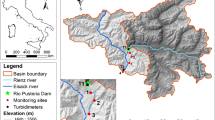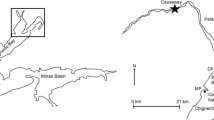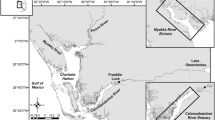Abstract
The macrobenthic fauna in the tidal freshwater James River, Virginia, USA, exhibited a high degree of resilience and limited temporal response to sediment disturbance caused by large quantities of low bulk density (< 1.3 g cm−3) fluid mud. The fluid mud was produced by hydraulic dredge deepening of a ship channel with disposal of dredged sediments onto a nearby shoal. The response of tidal freshwater communities to fluid mud was limited to mainly quantitative changes in abundance of dominant taxa (Limnodrilus spp., L. hoffmeisteri, Ilyodrilus templetoni, Corbicula fluminea, Coelotanypus scapularis) and was directly related to the thickness of fluid mud layers. Disturbance effects were short lived and for tubificids most obvious in areas with > 0.3 m fluid mud. In areas that received < 0.3 m fluid mud, acute effects were limited to chironomids and small (< 10 mm) C. fluminea. The fauna colonizing the areas disturbed by fluid mud was the same as that inhabiting the shoal prior to disturbance. There was no indication of a successional sequence, as reported for other freshwater and marine habitats. Three weeks after the disturbance ended, all but a few insect taxa had recolonized. Changes in community structure from fluid mud disturbance were slight with total taxa best characterizing the disturbance. The insensitivity of community structure measures reflects the high resiliency of macrobenthic communities to physical stresses in tidal freshwater systems.
Similar content being viewed by others
References
Agresti, A., 1990. Categorical data analysis. John Wiley & Sons, N.Y., 558 pp.
Brinkhurst, R. O., 1974. The benthos of lakes. St. Martin's Press, N.Y., 190 pp.
Denslow, J. S., 1985. Disturbance-mediated coexistence of species. In S. T. A. Pickett & P. S. White (eds), The Ecology of Natural Disturbance and Patch Dynamics. Academic Press, San Diego: 307–323.
Diaz, R. J., 1974. Asiatic clam, Corbicula manilensis (Philippi), in the tidal James River, Virginia. Chesapeake Sci. 15: 118–120.
Diaz, R. J. 1980. Ecology of tidal freshwater and estuarine Tubificidae (Oligochaeta). In R. O. Brinkhurst & D. Cook (eds), Aquatic Oligochaete Biology. Plenum Press, New York: 319–330.
Diaz, R. J., 1989. Pollution and tidal benthic communities of the James River Estuary, Virginia. Hydrobiologia 180: 195–211.
Diaz, R. J., 1992. Ecosystem assessment using estuarine and marine benthic community structure. In G. A. Burton (ed.), Sediment Toxicity Assessment, Lewis Publishers, Boca Raton: 67–85.
Diaz, R. J. & D. F. Boesch, 1977. Impact of fluid mud dredged material on benthic communities of the tidal James River, Virginia. Tech. Rpt. TR-D-77–45, U.S. Army Corps Engin., Waterways Exp. Stat., Vicksburg, Miss., 57 pp.
Fisher, J. A. & A. M. Beeton, 1975. The effect of dissolved oxygen on the burrowing behavior of Limnodrilus hoffmeisteri (Oligochaeta). Hydrobiologia 42: 273–290.
Folk, R. L., 1968. Petrology of sedimentary rocks. Hemphill's, Austin, 170 pp.
Grant, G. C. & J. E. Olney, 1991. Distribution of striped bass Morone saxatilis (Walbaum) eggs and larvae in major Virginia rivers. Fish. Bull. 89: 187–193.
Grassle, J. F. & J. P. Grassle, 1974. Opportunistic life histories and genetic systems in marine benthic polychaetes. J. Mar. Res. 32: 253–284.
Howarth, R. W., J. R. Fruci & D. Sherman, 1991. Inputs of sediment and carbon to an estuarine ecosystem: influence of land use. Ecol. Appl. 1: 27–39.
Inglis, C. C. & F. H. Allen, 1957. The regimen of the Thames Estuary as affected by currents, salinities and river flow. Proc. Inst. Civil Engin. 7: 827–878.
Jean, G. S. & R. E. Pine, 1975. Environmental effects of dredging and spoil disposal. J. Water Poll. Cont. Fed. 47: 553–561.
Lopez, G. R., 1988. Comparative ecology of the macrofauna of freshwater and marine muds. Limnol. Ocenaogr. 33: 946–962.
McCall, P. L. & F. M. Soster, 1990. Benthos response to disturbance in Western Lake Erie: regional faunal surveys. Can. J. Fish. Aquat. Sci. 47: 1996–2009.
Morton, J. W., 1977. Ecological effects of dredging and dredged spoil disposal: a literature review. U.S. Fish Wildl. Tech. Paper 94, 33 pp.
Nichols, M. M., 1979. The problem of misplaced sediment. In H. D. Palmer & M. G. Gross (eds), Ocean Dumping and Marine Pollution, Dowden, Hutchinson & Ross, Stroudsburg, Pa.: 147–161.
Nichols, M. M., G. S. Thompson & R. W. Fass, 1978. A field study of fluid mud dredged materials; its physical nature and disposal. Tech. Rpt. TR-D-78–40, U.S. Army Corps Engin., Waterways Exp. Stat., Vicksburg, Miss. (NTIS AD A058 952), 74 pp.
Odum, W. E., T. J. Smith, J. K. Hoover & C. C. Mclvor, 1984. The ecology of tidal freshwater marshes of the United States east coast: a community profile. U.S. Fish Wildl. Serv. FWS/OBS-83/17. 177 pp.
Pearson, T. H. & R. Ronsenberg, 1978. Macrobenthic succession in relation to organic enrichment and pollution of the marine environment. Ocenaogr. Mar. Biol. Annu. Rev. 16: 229–311.
Picket, S. T. A. & P. S. White, 1985. Patch dynamics: a synthesis. In S. T. A. Pickett & P. S. White (eds), The Ecology of Natural Disturbance and Patch Dynamics. Academic Press, San Diego: 371–384.
Pfannkuche, O., 1981. Distribution, abundance and life cycles of aquatic Oligochaeta (Annelida) in a freshwater tidal flat of the Ele Estuary. Arch hydrobiol. Suppl. 43: 506–524.
Pfannkuche, O., H. Jelinek & E. Hartwig, 1975. Zur fauna eines susswasserwattes im Elbe-Aestuar. Arch. Hydrobiol. 76: 475–498.
Pielou, E. C. 1975. Ecological diversity. Wiley-Interscience, N.Y., 196 pp.
Setzler-Hamilton, E. M., 1987. Utilization of Chesapeake Bay by early life history stages of fishes. In S. K. Majumdar, L. W. Hall & H. M. Austin (eds), Contaminant Problems and Management of Living Chesapeake Bay Resources. Pennsylvania Academy of Science, Philadelphia: 159–164.
Soster, F. M. & P. L. McCall, 1990. Benthos response to disturbance in Western Lake Erie: field experiments. Can. J. Fish. Aquat. Sci. 47: 1970–1985.
Swift, M. C. & R. B. Forward, 1988. Absolute light intensity vs. rate of relative change in light intensity: The role of light in the vertical migration of Chaoborus punctipennis larvae. Bull. Mar. Sci. 43: 604–619.
Tevesz, M. J. S., 1985. Benthic colonization in fresh water: a synthesis. Kirtlandia 41: 3–14.
van den Broek, W. L. F., 1978. Dietary habits of fish populations in the Lower Medway Estuary. J. Fish. Biol. 13: 645–654.
Wolanski, E., J. Chappell, P. Ridd & R. Vertessy, 1988. Fluidization of mud in estuaries. J. Geophys. Res. 93: 2351–2361.
Author information
Authors and Affiliations
Rights and permissions
About this article
Cite this article
Diaz, R.J. Response of tidal freshwater macrobenthos to sediment disturbance. Hydrobiologia 278, 201–212 (1994). https://doi.org/10.1007/BF00142328
Issue Date:
DOI: https://doi.org/10.1007/BF00142328




